Field Investigation of Water Infiltration into a Three-Layer Capillary Barrier Landfill Cover System Using Local Soils and Construction Waste
Abstract
1. Introduction
2. Materials and Methods
2.1. Testing Site
2.2. Materials and Construction Methods
2.3. Instrumentation Program
2.3.1. Layout of Instruments
2.3.2. Instruments, Calibrations, and Installing Methods
3. Results
3.1. Pore Water Pressure
3.2. Percolation
4. Discussion
5. Conclusions
- (1)
- In the wet season, the breakthrough of the upper two layers did not occur until a No. 3 rainfall whose daily precipitation was 108.8 mm. After the breakthrough, the upper two layers were wet until 15 September 2016. In this period, the pore water pressure in the underlying screened soil layer increased slightly and thus a major percolation occurred.
- (2)
- The pore water pressure in the screened soil layer near the bottom was at a high level, and not correlated with daily precipitation. It may be due to the influence of the high humidity of the landfill gas.
- (3)
- The increase in the pore water pressure in the upper two layers subjected to heavy rainfalls depended on not only the daily precipitation, but also the hydraulic state. Rainfall patterns significantly impact pore water pressure and percolation, with the combination of a short-duration, intense rainfall and prolonged weak rainfall notably extending the duration of saturated conditions and leading to significant percolation.
- (4)
- Over the six-month period from June to December, the cumulative percolation in the study measured approximately 10 mm. These results indicate that the three-layer capillary barrier cover system, which integrates local soils and construction waste (CW), demonstrated initial effectiveness under the field conditions of a humid climate observed during the study period.
- (5)
- The percolation rate increased as the average pore water pressure in the CW layer increased. In order to satisfy the allowable percolation rate of 30 mm/year, the pore water pressure in the CW layer should be smaller than −3 kPa.
Author Contributions
Funding
Data Availability Statement
Conflicts of Interest
Appendix A
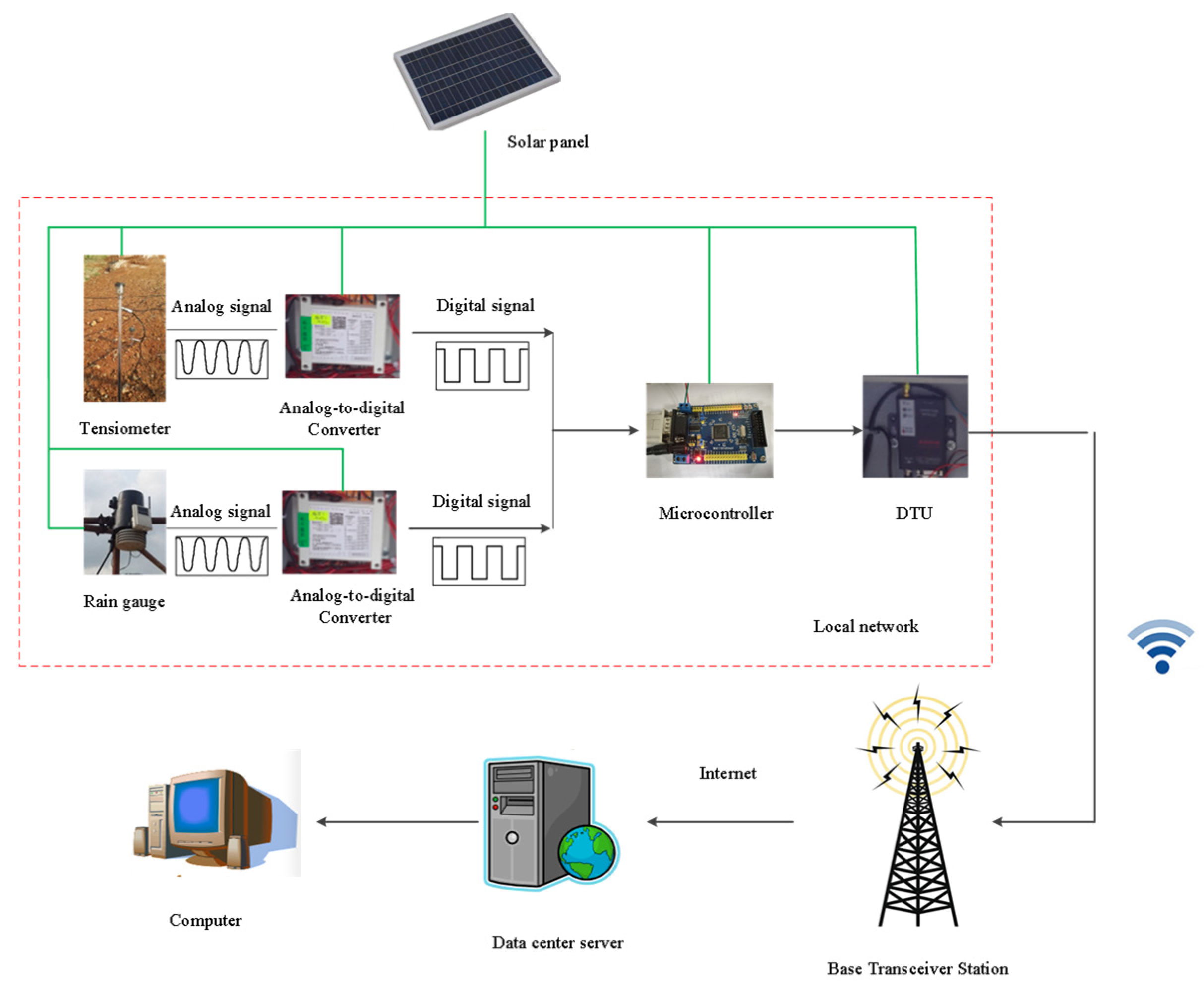
References
- Ng, C.W.W.; Liu, J.; Chen, R.; Lim, C.J. Numerical parametric study of an alternative three-layer capillary barrier cover system. Environ. Earth Sci. 2015, 74, 4419–4429. [Google Scholar] [CrossRef]
- Ng, C.W.; Liu, J.; Chen, R.; Xu, J. Physical and numerical modeling of an inclined three-layer (silt/gravelly sand/clay) capillary barrier cover system under extreme rainfall. Waste Manag. 2015, 38, 210–221. [Google Scholar] [CrossRef] [PubMed]
- Ng, C.W.; Coo, J.L.; Chen, Z.K.; Chen, R. Water Infiltration into a New Three-Layer Landfill Cover System. J. Environ. Eng. 2015, 142, 04016007. [Google Scholar] [CrossRef]
- Ng, C.W.W.; Guo, H.; Ni, J.; Chen, R.; Xue, Q.; Zhang, Y.; Feng, Y.; Chen, Z.; Feng, S.; Zhang, Q. Long-term field performance of non-vegetated and vegetated three-layer landfill cover systems using construction waste without geomembrane. Geotechnique 2022. ahead of the print. [Google Scholar] [CrossRef]
- Albrecht, B.A.; Benson, C.H. Effect of Desiccation on Compacted Natural Clays. J. Geotech. Geoenviron. Eng. 2001, 127, 67–75. [Google Scholar] [CrossRef]
- Barnswell, K.D.; Dwyer, D.F. Two-year performance by evapotranspiration covers for municipal solid waste landfills in northwest Ohio. Waste Manag. 2012, 32, 2336–2341. [Google Scholar] [CrossRef] [PubMed]
- Zhan, G.; Lattin, D.; Keller, J.; Milczarek, M. 20 Years of Evapotranspiration Cover Performance of the Leach Pads at Richmond Hill Mine. Mine Water Environ. 2019, 38, 402–409. [Google Scholar] [CrossRef]
- Rahardjo, H.; Santoso, V.A.; Leong, E.C.; Ng, Y.S.; Hua, C.J. Performance of an Instrumented Slope Covered by a Capillary Barrier System. J. Geotech. Geoenviron. Eng. 2012, 138, 481–490. [Google Scholar] [CrossRef]
- Zhan, L.T.; Li, G.Y.; Jiao, W.G.; Lan, J.W.; Chen, Y.M.; Shi, W. Performance of a compacted loess/gravel cover as a capillary barrier and landfill gas emissions controller in Northwest China. Sci. Total Environ. 2020, 718, 137195. [Google Scholar] [CrossRef]
- Shaikh, J.; Bordoloi, S.; Yamsani, S.K.; Sekharan, S.; Rakesh, R.R.; Sarmah, A.K. Long-term hydraulic performance of landfill cover system in extreme humid region: Field monitoring and numerical approach. Sci. Total Environ. 2019, 688, 409–423. [Google Scholar] [CrossRef]
- Yu, Y.; Zhao, X.; Shi, Y.; Ou, J. Design of a real-time overload monitoring system for bridges and roads based on structural response. Measurement 2013, 46, 345–352. [Google Scholar] [CrossRef]
- Kraimeche, B. Performance of a GSM/GPRS System Subject to Interference. In Proceedings of the 2005 5th International Conference on Information Communications & Signal Processing, Bangkok, Thailand, 6–9 December 2005; pp. 249–252. [Google Scholar] [CrossRef]
- ASTM D 422; Standard Test Methods for Particle-Size Analysis of Soils. ASTM International: West Conshohocken, PA, USA, 2007.
- ASTM D 4318; Standard Test Methods for Liquid Limit, Plastic Limit, and Plasticity Index of Soils. ASTM International: West Conshohocken, PA, USA, 2017.
- ASTM D 698; Standard Test Methods for Laboratory Compaction Characteristics of Soil Using Standard Effort [12,400 ft-lbf/ft3 (600 kN-m/m3)]. ASTM International: West Conshohocken, PA, USA, 2021.
- ASTM D 5084; Standard Test Methods for Measurement of Hydraulic Conductivity of Saturated Porous Materials Using a Flexible Wall Permeameter. ASTM International: West Conshohocken, PA, USA, 2016.
- Simion, I.M.; Fortuna, M.E.; Bonoli, A.; Gavrilescu, M. Comparing environmental impacts of natural inert and recycled construction and demolition waste processing using LCA. J. Environ. Eng. Landsc. Manag. 2013, 21, 273–287. [Google Scholar] [CrossRef]
- Chen, Z.; Feng, Q.; Yue, R.; Chen, Z.; Moselhi, O.; Soliman, A.; Hammad, A.; An, C. Construction, renovation, and demolition waste in landfill: A review of waste characteristics, environmental impacts, and mitigation measures. Environ. Sci. Pollut. Res. 2022, 29, 46509–46526. [Google Scholar] [CrossRef] [PubMed]
- Vasvári, V. Calibration of tipping bucket rain gauges in the Graz urban research area. Atmos. Res. 2005, 77, 18–28. [Google Scholar] [CrossRef]
- Soilmoisture. Model 2725A Jet Fill Tensiometer Operating Instructions; Soilmoisture Equipment Corp.: Santa Barbara, CA, USA, 1997. [Google Scholar]
- Chen, R.; Liu, J.; Ng, C.W.W.; Qiao, J. Development of a new assembled-type tensiometer. Rock Soil Mech. 2013, 34, 3028–3032. [Google Scholar] [CrossRef]
- Feng, W.Q.; Liu, Z.Y.; Tam, H.Y.; Yin, J.H. The pore water pressure sensor based on Sagnac interferometer with polarization-maintaining photonic crystal fiber for the geotechnical engineering. Measurement 2016, 90, 208–214. [Google Scholar] [CrossRef]
- Wang, L.; Liu, S.; Shen, C.; Lu, Y. Laboratory test and modelling of gas pressure under geomembrane subjected to the rise of groundwater in plain reservoirs. Geotext. Geomembr. 2020, 49, 81–96. [Google Scholar] [CrossRef]
- Shenzhen Statistics Bureau, NBS Survey Office in Shenzhen. Shenzhen Statistical Yearbook; China Statistics Press: Beijing, China, 2017. [Google Scholar]
- Wu, M.; Lam, H.; Li, K. Characterization and indexing of heavy rainstorms in Hong Kong. Meteorol. Appl. 2015, 22, 25–36. [Google Scholar] [CrossRef]
- Ng, C.W.; Liu, J.; Chen, R. Numerical Investigation on Gas Emission from Three Landfill Soil Covers under Dry Weather Conditions. Vadose Zone J. 2015, 14, vzj2014.12.0180. [Google Scholar] [CrossRef]
- Avzalshoev, Z.; Uchimura, T. An experimental approach to investigating Quasi-Saturation using Darcy’s Law. Sustainability 2023, 15, 10459. [Google Scholar] [CrossRef]
- Yang, J.; Ma, X.Q. The benefit of landfill gas power generation to the reduction of the greenhouse gas emission. Environ. Pollut. Control 2006, 28, 461–464. [Google Scholar]
- Piechota, G.; Hagmann, M.; Buczkowski, R. Removal and determination of trimethylsilanol from the landfill gas. Bioresour. Technol. 2012, 103, 16–20. [Google Scholar] [CrossRef] [PubMed]
- Benson, C.; Abichou, T.; Albright, W.; Gee, G.; Roesler, A. Field Evaluation of Alternative Earthen Final Covers. Int. J. Phytoremediat. 2001, 3, 105–127. [Google Scholar] [CrossRef]
- Baker, E.A.; Manenti, S.; Reali, A.; Sangalli, G.; Tamellini, L.; Todeschini, S. Combining noisy well data and expert knowledge in a Bayesian calibration of a flow model under uncertainties: An application to solute transport in the Ticino basin. arXiv 2022, arXiv:2210.17388. [Google Scholar] [CrossRef]
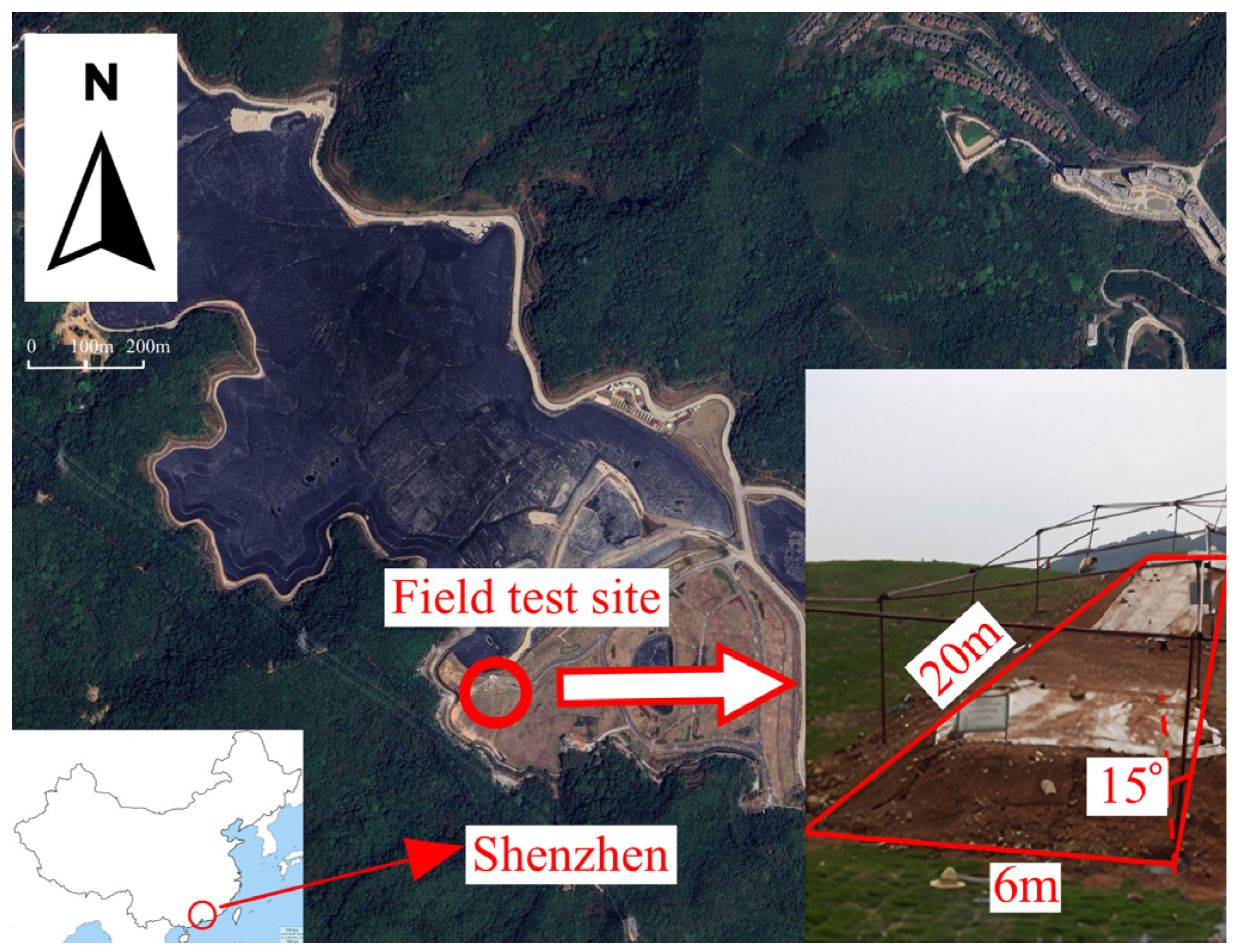
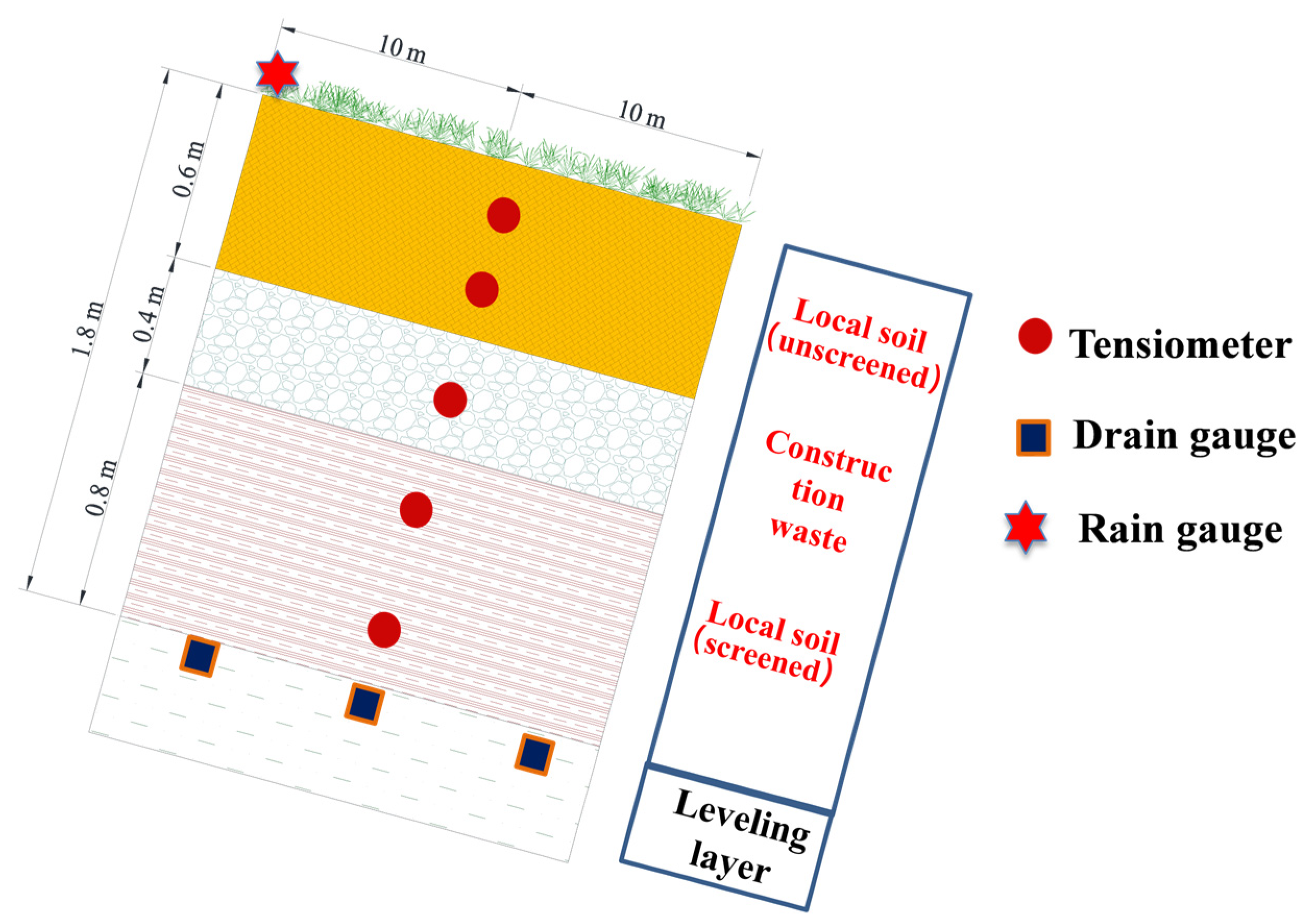
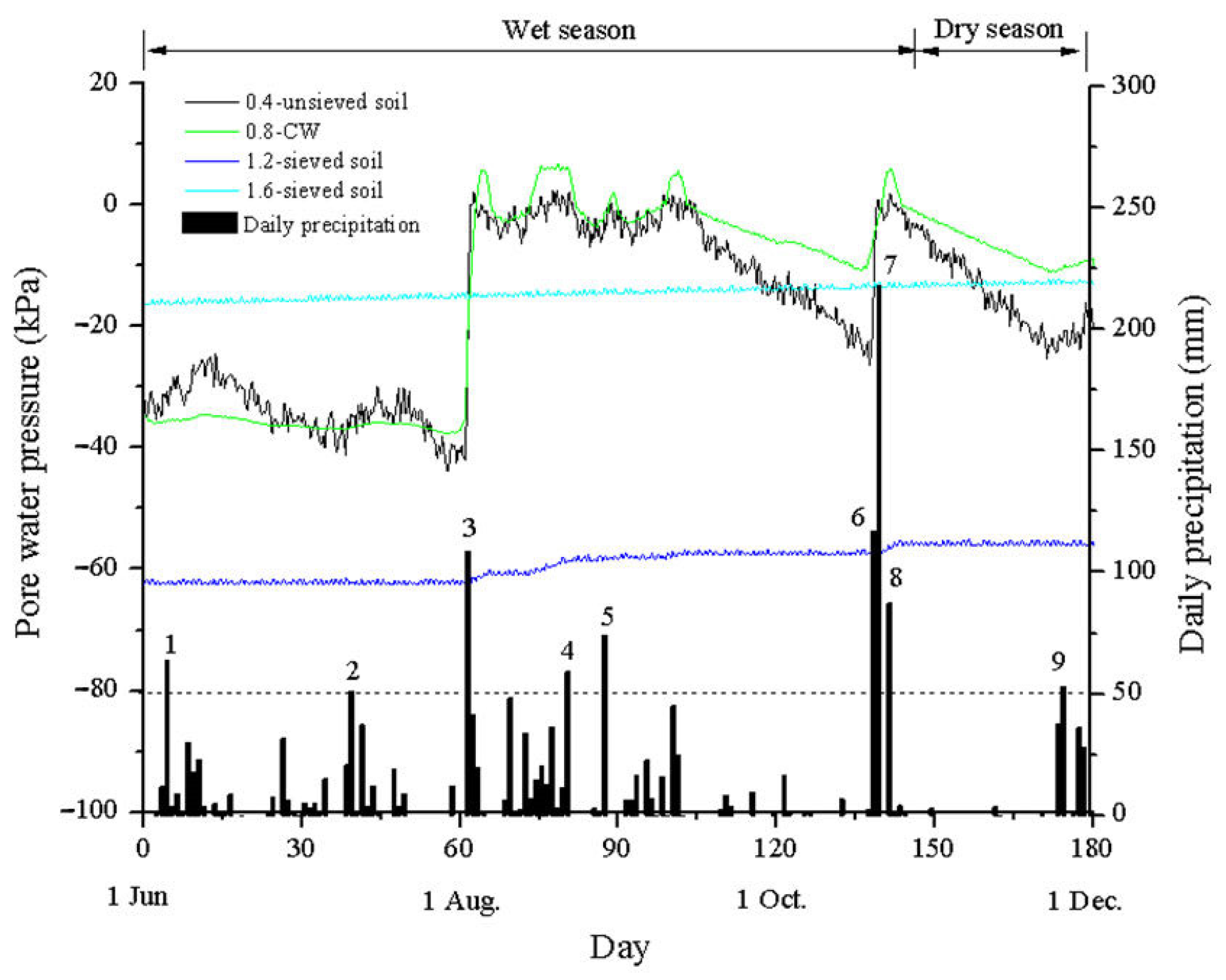
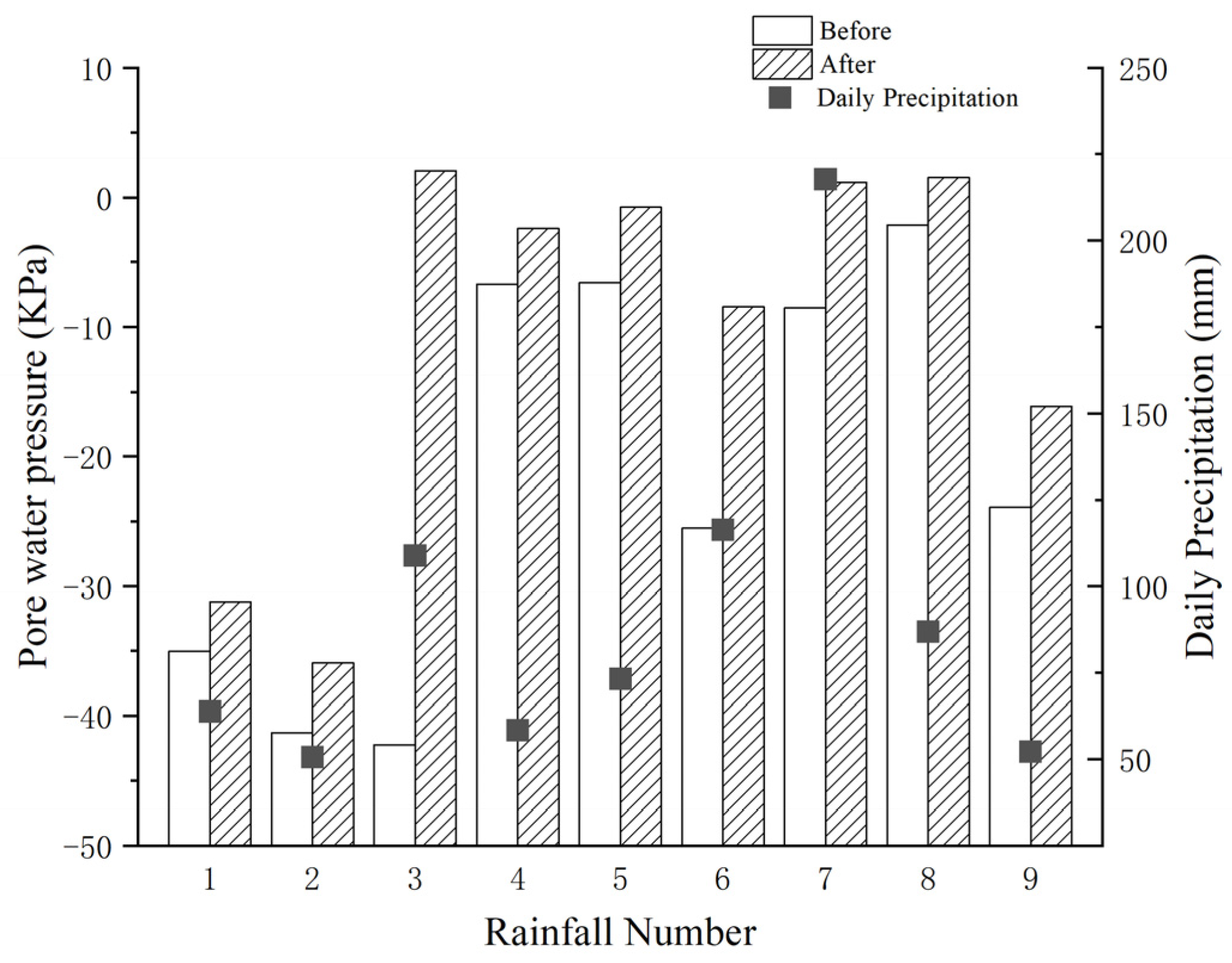
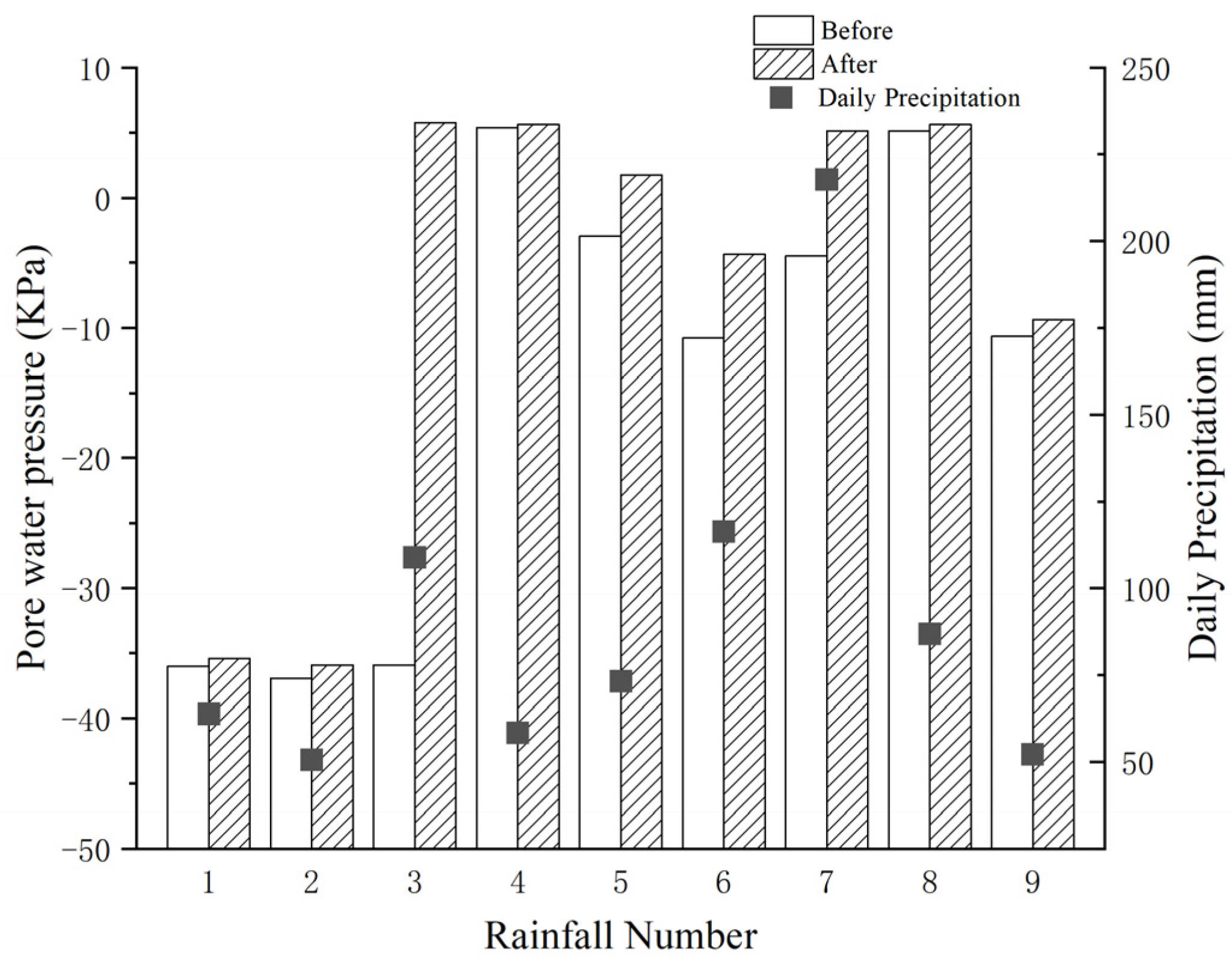
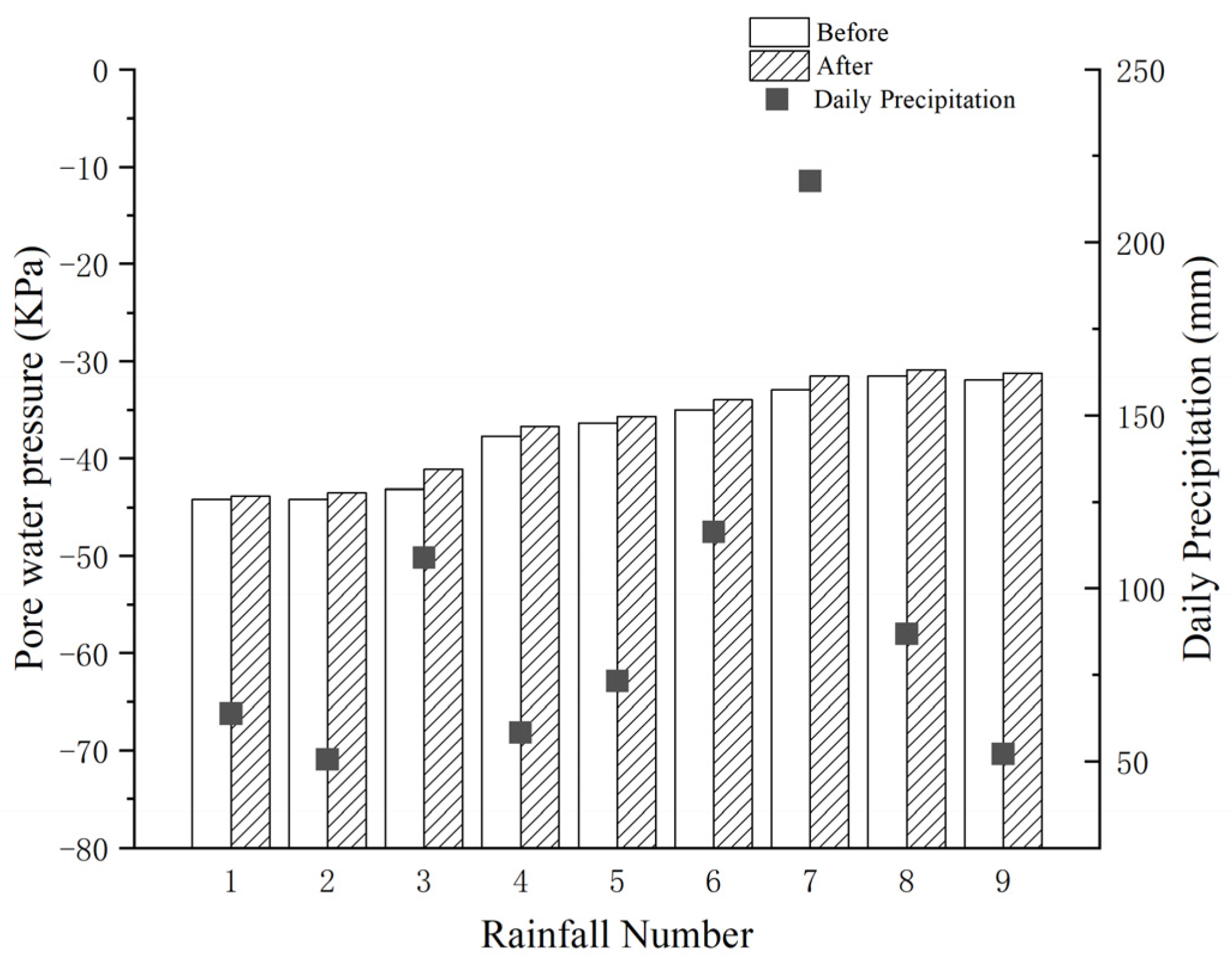
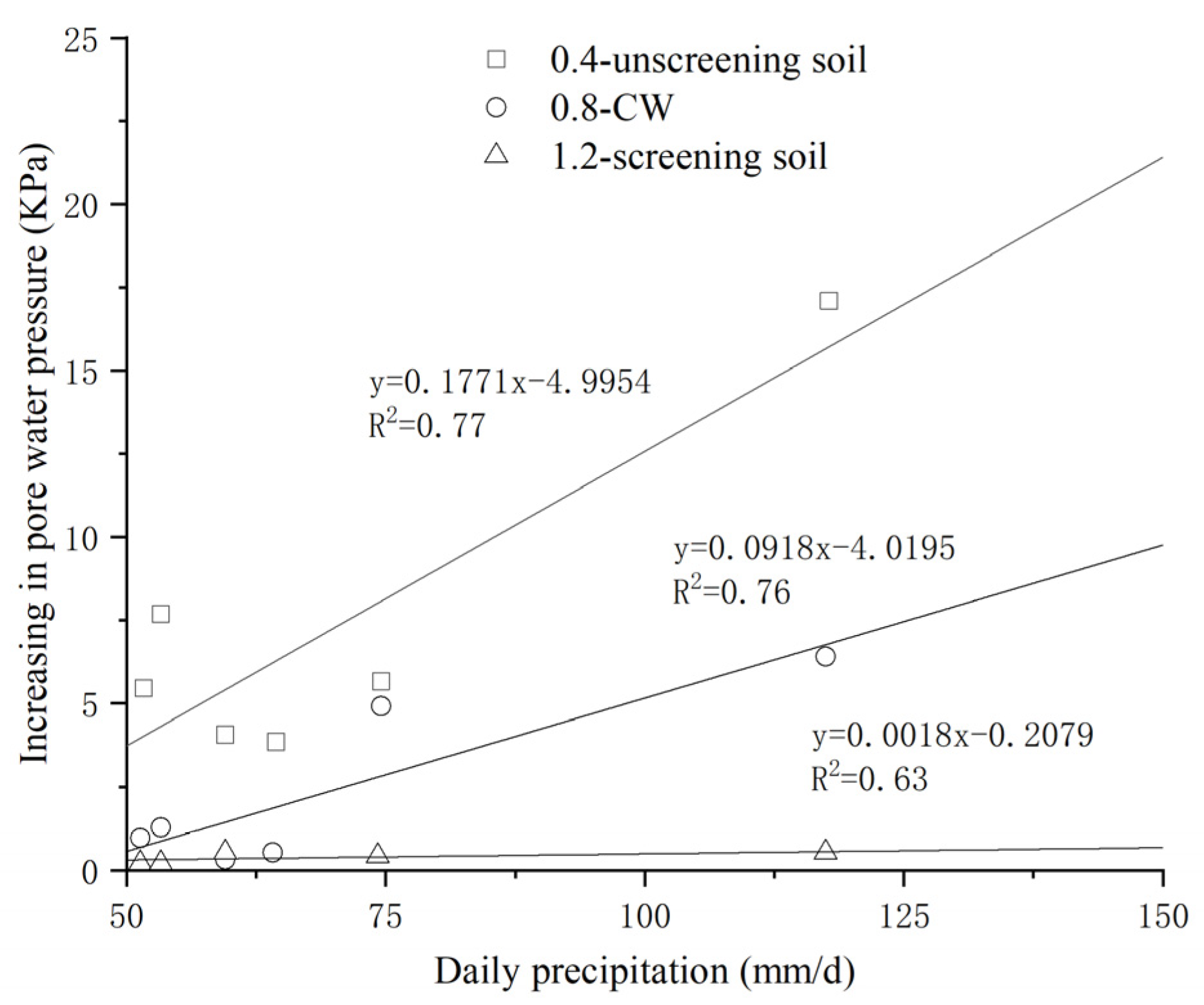
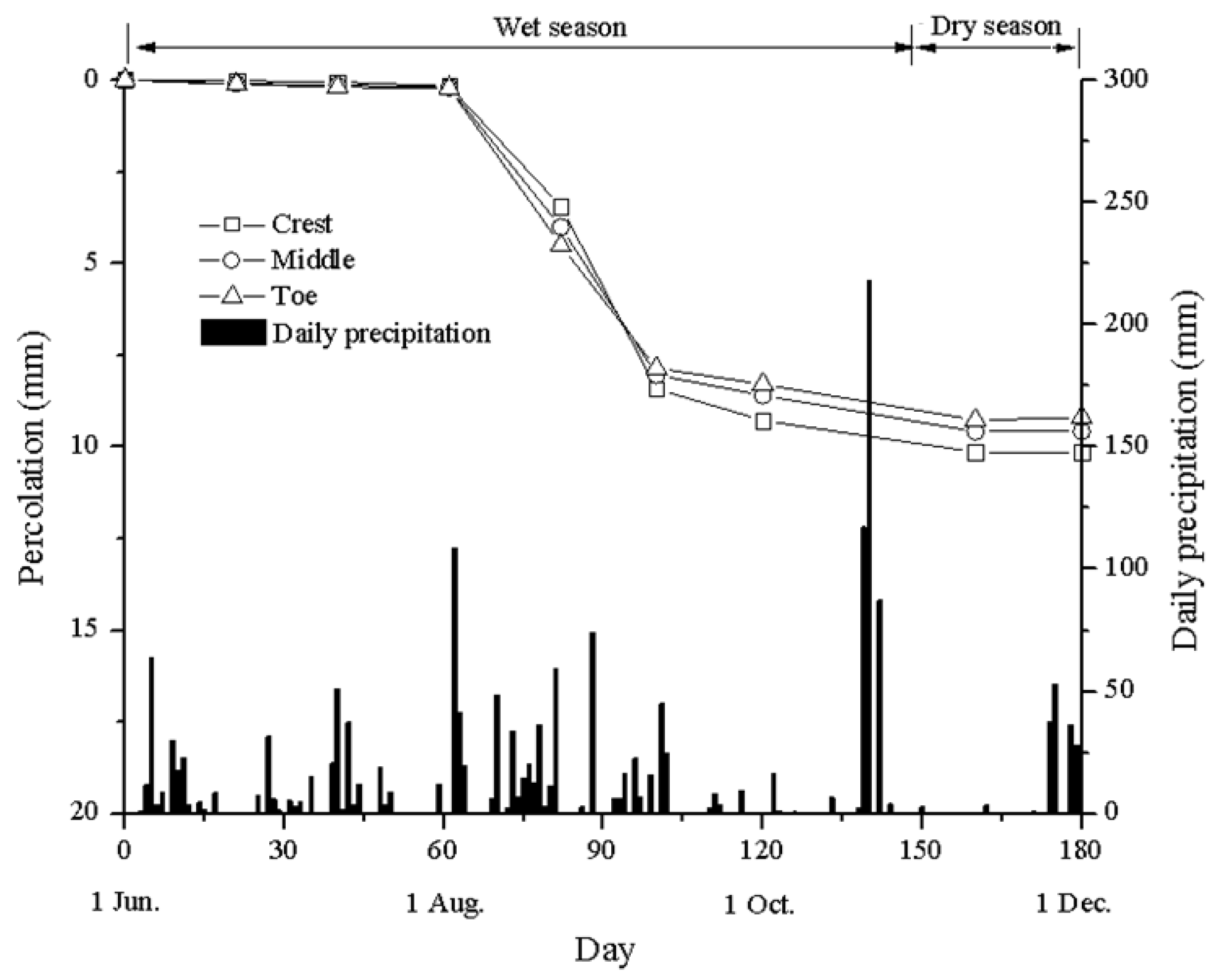
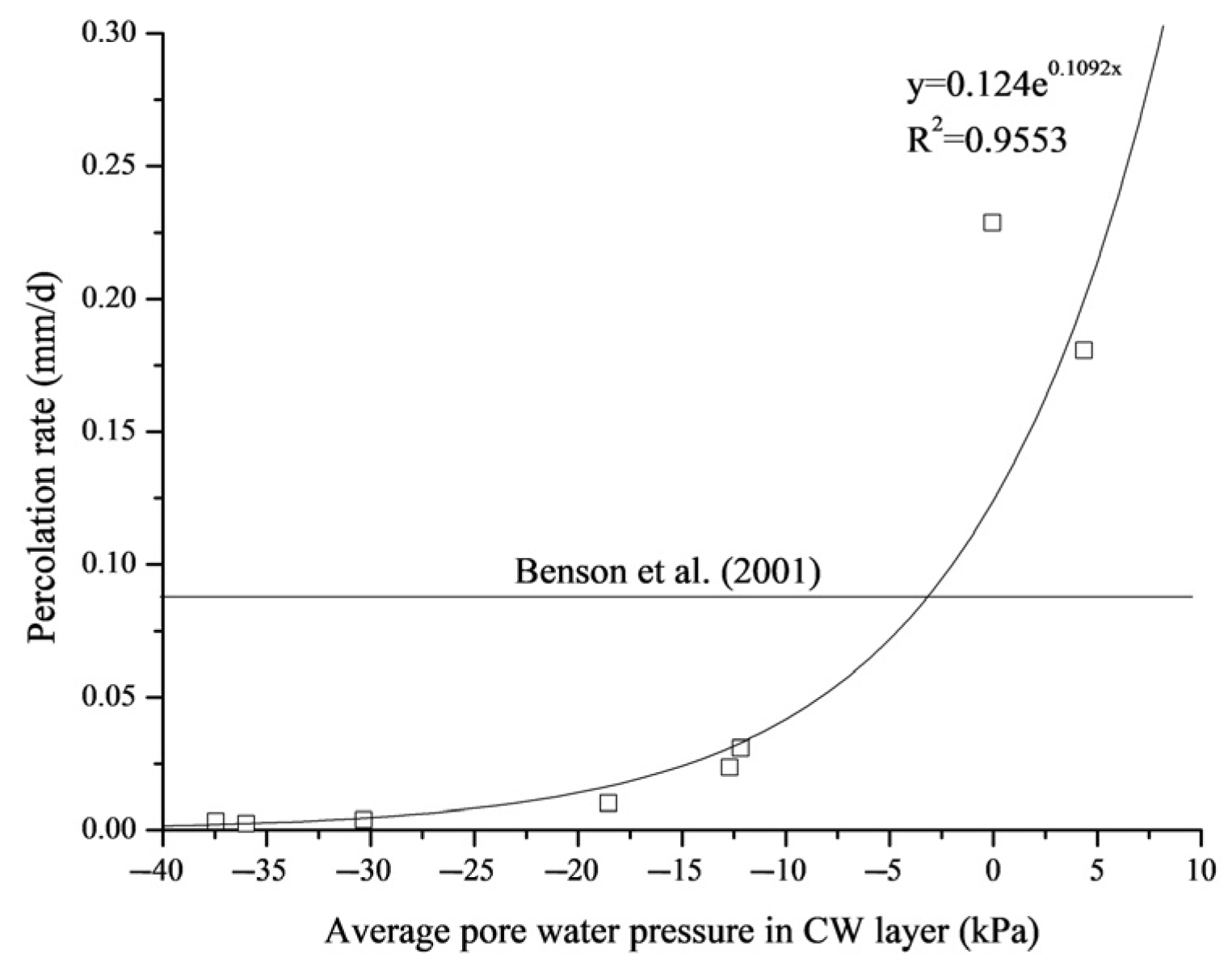
| Soil Type | Unscreened Soil | Construction Waste | Screened Soil | |
|---|---|---|---|---|
| Unified soil classification system | SC | GW | SC | |
| Liquid limit, LL (%) | 37 | / | 37 | |
| Plastic limit, PL (%) | 20 | / | 20 | |
| Grain size distribution | D60 (mm) | 0.298 | 20.1 | 0.165 |
| D30 (mm) | 0.091 | 8.9 | 0.032 | |
| D10 (mm) | 0.006 | 2.3 | 0.003 | |
| Fine content (0.075 mm; %) | 25.2 | / | 40.0 | |
| Coefficient of uniformity, Cu | 49.6 | 8.7 | 55 | |
| Coefficient of curvature, Cc | 4.6 | 1.7 | 2.1 | |
| Maximum dry density, ρd (Mg/m3) | 1.86 | 1.89 | 1.82 | |
| Saturated coefficient of permeability, ks (m/s) | 5 × 10−7–9 × 10−7 | 6 × 10−2–1 × 10−1 | 1.0 × 10−8–3.0 × 10−8 | |
| No. | Measurement | Type of Instrument | Quantity | Measuring Range/Accuracy |
|---|---|---|---|---|
| 1 | Pore water pressure | Jet-fill tensiometers | 5 | −90–100 kPa/0.1 kPa |
| 2 | Pore pressure transducers | 5 | ||
| 3 | Percolation | Drain gauge | 3 | No limit/0.1 mm |
| 4 | Precipitation | Rain gauge | 1 | 0–50 mm/min/0.2 mm/min |
Disclaimer/Publisher’s Note: The statements, opinions and data contained in all publications are solely those of the individual author(s) and contributor(s) and not of MDPI and/or the editor(s). MDPI and/or the editor(s) disclaim responsibility for any injury to people or property resulting from any ideas, methods, instructions or products referred to in the content. |
© 2024 by the authors. Licensee MDPI, Basel, Switzerland. This article is an open access article distributed under the terms and conditions of the Creative Commons Attribution (CC BY) license (https://creativecommons.org/licenses/by/4.0/).
Share and Cite
Wu, Y.; Ren, J.; Liu, J. Field Investigation of Water Infiltration into a Three-Layer Capillary Barrier Landfill Cover System Using Local Soils and Construction Waste. Buildings 2024, 14, 139. https://doi.org/10.3390/buildings14010139
Wu Y, Ren J, Liu J. Field Investigation of Water Infiltration into a Three-Layer Capillary Barrier Landfill Cover System Using Local Soils and Construction Waste. Buildings. 2024; 14(1):139. https://doi.org/10.3390/buildings14010139
Chicago/Turabian StyleWu, Yuedong, Jincheng Ren, and Jian Liu. 2024. "Field Investigation of Water Infiltration into a Three-Layer Capillary Barrier Landfill Cover System Using Local Soils and Construction Waste" Buildings 14, no. 1: 139. https://doi.org/10.3390/buildings14010139
APA StyleWu, Y., Ren, J., & Liu, J. (2024). Field Investigation of Water Infiltration into a Three-Layer Capillary Barrier Landfill Cover System Using Local Soils and Construction Waste. Buildings, 14(1), 139. https://doi.org/10.3390/buildings14010139






